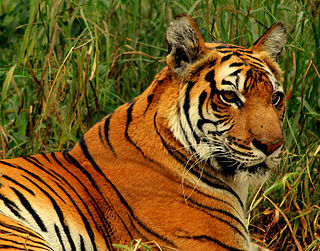
The fauna of Australia consists of a large variety of animals; some 46% of birds, 69% of mammals, 94% of amphibians, and 93% of reptiles that inhabit the continent are endemic to it. This high level of endemism can be attributed to the continent's long geographic isolation, tectonic stability, and the effects of a unique pattern of climate change on the soil and flora over geological time. A unique feature of Australia's fauna is the relative scarcity of native placental mammals. Consequently, the marsupials – a group of mammals that raise their young in a pouch, including the macropods, possums and dasyuromorphs – occupy many of the ecological niches placental animals occupy elsewhere in the world. Australia is home to two of the five known extant species of monotremes and has numerous venomous species, which include the platypus, spiders, scorpions, octopus, jellyfish, molluscs, stonefish, and stingrays. Uniquely, Australia has more venomous than non-venomous species of snakes.

An egg is an organic vessel grown by an animal to carry a possibly fertilized egg cell and to incubate from it an embryo within the egg until the embryo has become an animal fetus that can survive on its own, at which point the animal hatches.
José Alberto de Oliveira Anchieta was a 19th-century Portuguese explorer and naturalist who, between 1866 and 1897, travelled extensively in Portuguese Angola, Africa, collecting animals and plants. His specimens from Angola and Mozambique were sent out to Portugal, where they were later examined by several zoologists and botanists, chiefly among them J.V. Barboza du Bocage.

India is the world's 8th most biodiverse region with a 0.46 BioD score on diversity index, 102,718 species of fauna and 23.39% of the nation's geographical area under forest and tree cover in 2020. India encompasses a wide range of biomes: desert, high mountains, highlands, tropical and temperate forests, swamplands, plains, grasslands, areas surrounding rivers, as well as island archipelago. Officially, three out of the 36 Biodiversity Hotspots in the world are present in India: the Himalayas, the Western Ghats, and the Indo-Burma region. To these may be added the Sundarbans and the Terrai-Duar Savannah grasslands for their unique foliage and animal species. These hotspots have numerous endemic species. Nearly 5% of India's total area is formally classified under protected areas.

Axel Johann Einar Lönnberg was a Swedish zoologist and conservationist. Lönnberg was born in Stockholm. He was head of the Vertebrate Department of the Naturhistoriska Riksmuseet from 1904 to 1933.

The fauna of Puerto Rico is similar to other island archipelago faunas, with high endemism, and low, skewed taxonomic diversity. Bats are the only extant native terrestrial mammals in Puerto Rico. All other terrestrial mammals in the area were introduced by humans, and include species such as cats, goats, sheep, the small Indian mongoose, and escaped monkeys. Marine mammals include dolphins, manatees, and whales. Of the 349 bird species, about 120 breed in the archipelago, and 47.5% are accidental or rare.
Istanbul Zoology Museum, more precisely Zoology Museum of Istanbul University is a natural history museum, located in Istanbul University's Vezneciler Campus at Fatih, Istanbul featuring animal collections. It was founded in 1933 and rearranged in 1989. The museum is owned and maintained by the Department of Biology at Faculty of Science.

India is one of the most biodiverse regions and is home to a large variety of wildlife. It is one of the 17 megadiverse countries and includes three of the world's 36 biodiversity hotspots – the Western Ghats, the Eastern Himalayas, and the Indo-Burma hotspot.
The wildlife of Eritrea is composed of its flora and fauna. Eritrea has 96 species of mammals and a rich avifauna of 566 species of birds.

The fauna of Ireland comprises all the animal species inhabiting the island of Ireland and its surrounding waters.

The wildlife of Lesotho is composed of its flora and fauna. Lesotho has 60 species of mammals and 339 species of birds.

The wildlife of Somalia includes the flora and fauna of Somalia, which is extremely diverse due to the country's location between the temperate and the tropical zones. Somalia has a long coastline, bordered by the Indian Ocean in the east and Red Sea in the north. The northwestern and central parts of the country are arid, or very dry. The southern and northeastern regions are semi-arid, receiving slightly more rainfall than the central and northwest regions. The coastal region is more humid due to its proximity to the ocean. Somalia is home to over 727 species of birds and boasts over 177 species of mammals.

The Museum of Evolution of Polish Academy of Sciences is the display area of the natural history museum in Warsaw, Poland. It is the public front of the Muzeum i Instytut Zoologii or Zoology Museum and the Instytut Paleobiologii or Paleobiology Institute. It is based at the Palace of Culture and Science.

The fauna of Italy comprises all the animal species inhabiting the territory of the Italian Republic and its surrounding waters. Italy has one of the highest levels of faunal biodiversity in Europe, with over 57,000 species recorded, representing more than a third of all European fauna. This is due to various factors. The Italian peninsula is in the centre of the Mediterranean Sea, forming a corridor between central Europe and North Africa, and it has 8,000 km (5,000 mi) of coastline. Italy also receives species from the Balkans, Eurasia, and the Middle East. Italy's varied geological structure, including the Alps and the Apennines, Central Italian woodlands, and Southern Italian Garigue and Maquis shrubland, also contribute to high climate and habitat diversity.

Gdynia Aquarium is a public aquarium and sea museum operated by the National Marine Fisheries Research Institute in Gdynia, Poland. Previously called the Oceanographic Museum and Sea Aquarium of the Sea Fisheries Institute in Gdynia (1971-2003), the aquarium has a zoological garden status and is situated along Aleja John Paul II on the South Pier.

Bogor Zoology Museum is a museum located to the next of the main entrance of the Bogor Botanical Gardens in the city of Bogor, Indonesia. The museum and its laboratory were founded in 1894 by government of Dutch East Indies during the colonial era. It contain one of the largest collection of preserved fauna specimens in Southeast Asia.

The fauna of Romania comprises all the animal species inhabiting the country of Romania and its coastal territory in the Black Sea.

The Fauna of Nepal includes 3.96% of mammals, 3.72% of butterflies and 8.9% of birds among the total number of species found in the world. The protected species in Nepal include 26 mammals, nine birds and three reptiles. The endemic fauna are: Himalayan field mouse, Spiny babbler, Nepali kalij, 14 herpetofauna, and six types of fishes.

The wildlife of Somaliland includes the flora and fauna of Somaliland, which is extremely diverse due to the country's location between the temperate and the tropical zones. Somaliland is bordered by the Red Sea. The coastal region is more humid due to its proximity to the ocean. Somaliland is home to over 727 bird species and boasts over 177 species of mammals.
















